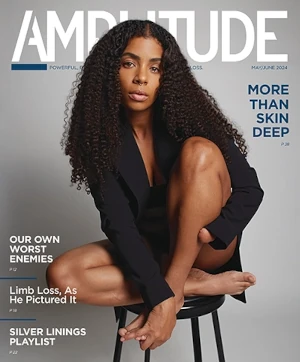
“Engineers and scientists too often leave prosthesis users out of the innovation process,” notes a recent article in Science Robotics. Titled “Touching Reality: Bridging the User-Researcher Divide in Upper-limb Prosthetics,” the paper offers several important ideas for the design community to close the sizable gap between amputees’ needs and the bionic arms and hands available to them.
“There is a better path forward,” the authors observe. “This path must involve bringing prosthesis users into the early brainstorming phase to truly understand their needs and desires for prosthesis utility and function.”
The paper is based on a workshop held at last summer’s World Haptics Conference and cowritten by a handful of prominent biotech researchers who participated in the session. Some of the authors are both users and designers of advanced upper-limb prostheses, including Susan Engdahl, lead researcher at the American Orthotic and Prosthetic Association (AOPA), and György Lévay, an award-winning engineer with Infinite Biomedical Technologies.
In “Touching Reality,” these industry leaders enumerate some general principles for elevating upper-limb amputees’ voices in the design of bionic arms. We came away with three signposts to point the way toward a more responsive, user-centric system.
1. Listen more closely to middle-class amputees.
Some amputees’ voices are more absent from the conversation than others. To the extent that researchers currently solicit feedback from end users, the authors write, “studies are likely to be overrepresented by individuals who have the economic ability to acquire cutting-edge prosthesis technology.” The upper end of the wealth spectrum is skewed by race, sex, geography, and multiple other factors, so researchers aren’t hearing a representative sample of amputees’ opinions.
“Without intervention, the scientific community is in danger of focusing only on the needs of individuals from certain socioeconomic levels,” the paper notes. Researchers must make a concerted effort to bring individuals of ordinary financial means into the discussion and devise solutions that meet their needs.
2. Break out of the lab and into the living room.
Present methods for gathering user input are almost completely limited to artificial, controlled environments that don’t authentically replicate real-world conditions. Such experiments do yield necessary, high-quality data regarding a bionic hand’s responsiveness, strength, ease of mastery, and other baseline factors, but they’re not true tests of the technology’s suitability for daily tasks. They reveal little to nothing about the device’s durability, the bodily wear and tear it inflicts, its aesthetic impact, or its maintenance and repair needs—all of which matter more to users than how many hundredths of a second it takes to change between grip patterns.
As one workshop participant noted: “I am less interested in technological advances than I am in a prosthesis that is comfortable, reliable, durable, and natural-looking. I wish my prosthesis was more user-serviceable, so every minor issue didn’t require a visit to my provider.”
3. Don’t be tempted by the lure of all-in-one technological fixes.
The strongest message that emerged from the World Haptics Conference workshop was that amputees’ prosthetic needs and preferences vary too widely to allow for universal solutions. Given the broad diversity of preferences and priorities, the authors write, “it is evident that no ‘one-size-fits-all’ approach will enable enhanced quality of life for all individuals.”
The implicit critique is that current R&D is too focused on attempts to mimic the human hand and replicate as many of its functions as possible. That objective, while admirable, leads designers to cram their devices full of grip patterns, touch sensors, mind-machine interfaces, and other features that offer broad application in theory, but narrow utility in practice. “Overall,” the paper concludes, “the outcomes of this workshop indicate a pressing need for more nuanced analyses of the true needs of prosthetic users.”




